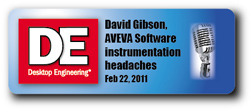February 21, 2011

At AVEVA Software, David Gibson, head of product strategy, electrical & instrumentation systems, and his colleagues keep a watchful eye on the industries they serve: process plant, power plant, and marine industries, among others. Periodically, they share the trends they’ve noticed and their findings in whitepapers.
Late last year, AVEVA published “Top Ten Instrumentation Headaches: How ‘visual engineering’ is solving designers’ and engineers’ issues—across the industry” (available for download for free at AVEVA’s media center online).
These headaches, commonly associated with the design, layout, and upkeep of control systems for plants, arise “because the technology used to plan and design instrumentation and control systems has often been developed with little regard for engineers’ and designers’ natural working methods,” noted the whitepaper’s authors. The pesky issues, as cataloged in the paper, are:
- Wasted time and lost productivity;
- Lack of change management;
- Wiring limitations;
- The catalog of errors;
- Lack of visualization and reporting clarity;
- The price of scalability;
- Vendor data breakdown;
- Inability to view instrumentation data in 3D context;
- Incomplete associations; and
- Fragmented bulk data upload.
Last December, Gibson agreed to discuss the top three headaches with me in a podcast interview. “The research gathering has a lot to do with the fact that we work with customers all over the world,” he said. “So we get a lot of feedback, and we know what the pain points are.”
Wasted time and lost productivity, Gibson observed, tend to occur during the second phase of the design. “In the initial phase of the design, the actual creation of a lot of information, gets you a burst of activity,” he said. “What waste a lot of time is actually changing that burst of activity to customer requirements ... The management of those changes is actually one of the root causes of wasted time.” These changes are inevitable, so a good antidote would be a system that allows you to make those changes and configuration with ease.
The use of in-house systems and home-grown applications modeled on spreadsheets may also contribute to the severity of headaches. With uncontrolled systems, designed mainly as a series of input fields, Gibson noted, “duplicating a tag number, for example, is a classic [error], very easy to do ... if you’re using a spreadsheet, nothing is constraining you to put in the right values.” By contrast, if you’re using a visual system with appropriate prompts, you’re less prone to such data entry errors. “If you draw a wire between two boxes, for instance, you need the system to prompt you for cable number,” said Gibson.
The paper’s authors contend that currently, there aren’t many suitable technologies to handle wiring, “a multi-phase process, involving loop diagrams, schedules and terminations.” They write, “The wiring designer has to coordinate design data manually between several different applications—an open invitation to error, as well as a seriously inefficient use of a technically skilled individual’s time.”
“In current systems, the input is usually by tables and spreadsheets,” noted Gibson. “There’s really no means of visualizing the relationships ...” 3D CAD users may find that they’re in a favorable position, as 3D CAD models can provide a graphical understanding of the plant layout, allowing you to design wiring loops and connections in the best possible manner.
“If you can actually take your visual, graphical [wire] design and then push that through a 3D model, it gives you the ability to check for all sorts of cable segregation, [check for] penetration ... As we move forward, the role of 3D is going to increase, because we’re all moving towards a wireless world ... The ability to handle clashes between volumes, wireless technologies, and field work will play a bigger role.”
Gibson also believes the current adoption of mobile devices—smart phones and WiFi-enabled tablets—is poised to change plant design and instrumentation protocols. “The iPhone is a great tool for bar-code reading,” he observed. “Being able to carry the whole plant of your design under your arm [with a device like an iPad] has a tremendous future. And the way you interact with these devices is not too dissimilar from how you interact with AVEVA software’s graphical interface.”
To download the paper from AVEVA, go to AVEVA’s online publication archive.
For more, listen to the complete podcast with David Gibson below:

Subscribe to our FREE magazine, FREE email newsletters or both!
About the Author
Kenneth Wong is Digital Engineering’s resident blogger and senior editor. Email him at [email protected] or share your thoughts on this article at digitaleng.news/facebook.
Follow DERelated Topics






